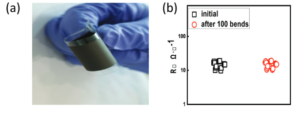
Shared posts
[ASAP] Achieving High-Quality Sn–Pb Perovskite Films on Complementary Metal-Oxide-Semiconductor-Compatible Metal/Silicon Substrates for Efficient Imaging Array
[ASAP] Probing Perovskite Photocatalysis. Interfacial Electron Transfer between CsPbBr3 and Ferrocene Redox Couple
[ASAP] Crystal Orientation and Grain Size: Do They Determine Optoelectronic Properties of MAPbI3 Perovskite?
[ASAP] Investigation on Thermally Induced Efficiency Roll-Off: Toward Efficient and Ultrabright Quantum-Dot Light-Emitting Diodes
Aminosilane‐Modified CuGaO2 Nanoparticles Incorporated with CuSCN as a Hole‐Transport Layer for Efficient and Stable Perovskite Solar Cells

CuGaO2 nanoparticles modified with aminosilane are used as a hole‐transporting layer with CuSCN for perovskite solar cells. The enhanced power conversion efficiency and thermal stability compared to the cell using only CuSCN are correlated with the improved carrier extraction and reduced interfacial degradation by the inorganic nanoparticles.
Abstract
Herein, solution‐processible inorganic hole‐transport layer (HTL) of a perovskite solar cell that consists of CuGaO2 nanoparticles and CuSCN, which leads to an improved device performance as well as long‐term stability, is reported. Uniform films of CuGaO2 are prepared by first treating CuGaO2 nanoparticles with aminosilane that leads to well‐dispersed CuGaO2 solution, followed by spin‐coating of the suspension. Subsequent spin‐coating of CuSCN solution onto the CuGaO2 forms a smooth HTL with excellent coverage and electrical conductivity. Comparing to the reference device with CuSCN HTL, the CuGaO2/CuSCN device improves carrier extraction and reduces trap density by ≈40%, as measured by photoluminescence and capacitance analysis. Excellent thermal stability is also demonstrated: ≈80% of the initial efficiency of the perovskite solar cells with the CuGaO2/CuSCN HTL is retained after 400 h under 85 °C/85% relative humidity environment.
Elucidating the Impact of Charge Selective Contact in Halide Perovskite through Impedance Spectroscopy

Charge accumulation: The specific role played by electron and hole selective layers in perovskite solar cell is elucidated at short circuit condition at diverse temperatures, charge accumulation at interfaces of perovskite is found and specifically charge accumulation at hole selective interface is higher as compared to electron selective interface.
Abstract
The electron and hole selective contact (SC) plays a pivotal role in the performance of perovskite solar cells. In order to separate the interfacial phenomenon from bulk, the influence of charge SC is elucidated, by means of impedance spectroscopy. The specific role played by TiO2 and Spiro‐OMeTAD as electron and hole SC in perovskite solar cells is investigated at short circuit condition at different temperatures. The methylammonium lead triiodide (MAPbI3) and mixed perovskite of formamidinium lead iodide and methylammonium lead bromide namely; (FAPbI3)0.85(MAPbBr3)0.15 are probed and parameters such as charge carrier mobility, recombination resistance, time constant, and charge carrier kinetics in perovskite layer and at the interface of perovskite/SC are elucidated. Charge carrier mobility in mixed perovskite is found to be nearly two order of magnitude higher as compared to MAPbI3. Moreover, the carrier mobility in devices with only electron SC is found to be higher as compared only hole SC. The charge accumulation at TiO2/perovskite/Spiro‐OMeTAD interfaces is studied via frequency dependent capacitance, revealing higher charge accumulation at perovskite/Spiro‐OMeTAD than at TiO2/perovskite interface. By performing varying temperature frequency dependent capacitance measurements the distribution of density of state within the bandgap of the perovskites, the emission rate of electrons from the trap states and traps activation energy is determined.
Managing Energy Loss in Inorganic Lead Halide Perovskites Solar Cells

Large energy loss has been a major obstacle for further efficiency improvement of inorganic perovskite solar cells. This review provides a basic understanding of energy loss and may inspire new designs or more impactful methods for further minimizing the energy loss of inorganic perovskite solar cells.
Abstract
Though the cesium‐based inorganic perovskite solar cells (IPSCs) have developed rapidly in recent two years, the power conversion efficiency (PCE) is still far away from the Shockley–Queisser limit due to the large open‐circuit voltage (V oc) deficit, which results from the large energy loss (E loss). Large E loss has been a major obstacle for further efficiency improvement of IPSCs. In this review, the authors, for the first time, focus on investigating the E loss of IPSCs and start from discussing the essence and origin of the E loss. Then, the reported efficient methods for reducing the band tails and energy disorder are systematically summarized and reviewed, including crystallization optimization, defect passivation, and interface engineering. Finally, the authors offer an overall perspective on managing E loss in IPSCs and point out the possible ways to reduce the E loss and promote the efficiency. This review provides a basic understanding of E loss and may inspire new designs or more impactful methods for further minimizing the E loss of IPSCs.
Using Carbon to Make a Better Solar Cell
Maybe I’m stating the obvious, but solar cells are incredibly complex devices with more components than just the light absorber.
While the focus on the active layer by chemists looking to develop new materials is understandable, in order to truly create next-generation solar cells the other components of the architecture must be improved. Creating the crack-resistant or resilient layers necessary for functional flexible solar cells is a major challenge currently being addressed. These new materials and approaches also need to work within the general framework of fabrication techniques used for the other layers – ideally at low temperature and solution processible.
An often-neglected piece of the puzzle is the electrode. Electrodes are traditionally composed of a thin metal layer, which is often vapor deposited at high temperatures and low pressures. This class of electrodes is expensive, susceptible to degradation, and can damage the critical hole transport or active layers. One emerging alternative is carbon-based electrodes, applied as pastes. These low-cost, highly stable, and hydrophobic materials are attractive given their compatibility with emerging photovoltaic technologies, particularly perovskites. Their broad application has been limited by the necessity of toxic solvents to create the pastes, but researchers in China have developed a low-temperature, highly conductive carbon paste that can be screen printed onto perovskite solar cells without using toxic solvents.

Figure 1. (a) Fabrication schematic for perovskite solar cells with carbon electrodes and hole transport layers. (b) Cross sectional SEM image of a device.
Not only are the solvents more environmentally friendly compared to those previously used, they also increase the mechanical strength of the final film and, under fabrication conditions, do not damage the perovskite active layer or organic hole transport layer. While the hole transport layer isn’t strictly necessary to create a working device, it has been shown to increase the champion efficiency from 11.7% to 14.55%. This is likely due to poor contact between the perovskite and carbon electrode, which the thin hole transport layer (PEDOT:PSS) helps remedy.

Figure 2. (a) A sample undergoing a bending test. (b) The electrode sheet resistance before and after 100 bends.
The most exciting aspect of these electrodes is their resilience when subjected to a bending test. After 100 bends, the researchers saw no visible film damage or increase in the sheet resistance when compared to the initial sample. Actual flexible solar cells fabricated and studied did show a decrease in performance after 1,000 bends, but this was attributed to known robustness issues in the base ITO layer. This work with carbon-based electrode materials could lead to simpler manufacturing for fabricating perovskite solar cells at a commercial level.
To find out more please read:
Shiyu Wang, Pei Jiang, Wenjian Shen, Anyi Mei, Sixing Xiong, Xueshi Jiang, Yaoguang Rong, Yiwen Tang, Yue Hu & Hongwei Han
Chem. Commun., 2019, 55, 2765-2768
This article is also part of the Chemical Communications ‘Perovskites‘ themed collection.
About the blogger:
Beth Mundy is a PhD candidate in chemistry in the Cossairt lab at the University of Washington in Seattle, Washington. Her research focuses on developing new and better ways to synthesize nanomaterials for energy applications. She is often spotted knitting in seminars or with her nose in a good book. You can find her on Twitter at @BethMundySci.
[ASAP] Highly Emissive and Stable Organic–Perovskite Nanocomposite Thin Films with Phosphonium Passivation
[ASAP] Mechanism of Single-Photon Upconversion Photoluminescence in All-Inorganic Perovskite Nanocrystals: The Role of Self-Trapped Excitons
[ASAP] Outstanding Challenges of Zero-Dimensional Perovskite Materials
[ASAP] Two Dimensions Are Better for Perovskites
[ASAP] The Causes of Degradation of Perovskite Solar Cells
[ASAP] Ligand-Mediated Release of Halides for Color Tuning of Perovskite Nanocrystals with Enhanced Stability
[ASAP] Journey of Making Cesium Lead Halide Perovskite Nanocrystals: What’s Next
[ASAP] Quantum Nature of Light in Nonstoichiometric Bulk Perovskites
Charge Carrier Collection and Contact Selectivity in Solar Cells

Selectivity is a figure of merit for the usefulness of a contact in a photovoltaic device. Here, previous quantitative definitions of selectivity are compared and combined. The influence of the built‐in potential on the selectivity is investigated and it is illustrated how this quantity can be measured.
Abstract
The electronic properties of the contacts to a photovoltaic absorber material are important for the final efficiency of any type of solar cell. For highly efficient solar cells based on high quality absorber materials like single‐crystalline silicon, polycrystalline Cu(In,Ga)Se2, CdTe, or metal‐halide perovskites, contact formation is even the decisive processing step determining the final efficiency. The present paper combines recently developed quantitative concepts for the description of contacts to solar cells in terms of their selectivity toward a more general description that is valid for all types of solar cells and all types of contacts. It is shown that the built‐in voltage is an important parameter to influence the selectivity of contacts to photovoltaic absorber materials. It is also shown that the contact selectivity is mathematically related to the collection efficiency which can be measured by luminescence based techniques.



















